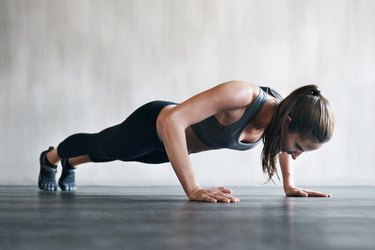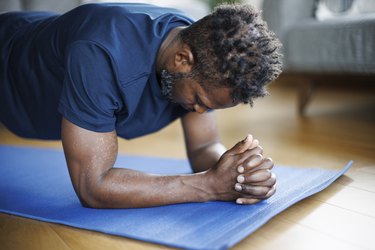
The push-up is one of the best exercises for your chest, arms, shoulders and core. The benefits of push-ups for a strong upper body include being able to carry your groceries, pick up a heavy box off the floor, grab something from a high shelf or open that stubborn jar of pickles. (More on the benefits of push-ups below.)
Some organizations even use and track a 1-minute or max push-up test to gauge strength. However, a 2021 survey of 2,000 people commissioned by Gymless.org found 53.8 percent of adults can't do more than 10 push-ups in a row.
Video of the Day
While push-ups are a limited measurement of your overall fitness, they do provide a good understanding of your upper-body muscular endurance.
So, if you're wondering, "how many push-ups should I be able to do?" take a look at what the average number of push-ups are for men and women by age to get an idea of where you stand — and learn how to improve your score.
A Note on Language
Here at LIVESTRONG.com, we make deliberate choices about the language we use. Throughout this article, we use the terms "men" and "women" to reflect the language used in studies and national data. But when it comes to the average push-ups performed, what researchers are really talking about is biological sex at birth.
According to a July 2021 study in the Journal of Strength and Conditioning Research, people assigned male at birth (AMAB) can generally perform more push-ups than people assigned female at birth (AFAB). Researchers believe this is because people AMAB are able to perform their push-ups at a faster pace, thanks to differences in average body weight distribution.
Average Number of Push-Ups: Adult Women Push-Up Chart
The average number of push-ups adults can do varies by age range and gender. The norms provided by the Kinesiologists.Ca Studios — which offers kinesiology and active rehab services in Surrey, British Columbia, Canada — break up the results into the following categories:
- Poor
- Below average
- Average
- Above average
- Excellent
Wondering how many push-ups you should be able to do? Check the chart below to get an idea of the average number of push-ups most women can perform by age.
Average Push-Ups for Adult Women
Age | Push-Ups |
|---|---|
15-19 | 18-24 |
20-29 | 15-20 |
30-39 | 13-19 |
40-49 | 11-14 |
50-59 | 7-10 |
60+ | 5-11 |
Of course, the average varies greatly across the general population due to diverse lifestyles, careers and health conditions. Barring a medical condition or injury that prevents you from exercising, consider improving your muscular endurance if you can't hit the average for your age group.
Women's Push-Up Scores Needing Improvement
Age | Number of Push-Ups |
|---|---|
15-19 | < 11 |
20-29 | < 9 |
30-39 | < 7 |
40-49 | < 4 |
50-59 | < 1 |
60+ | < 1 |
Average Number of Push-Ups: Adult Men Push-Up Chart
The average number of push-ups for adult men are higher than the average scores for their female counterparts. Take a look at the chart below to learn the average number of push-ups for men by age group.
Average Push-Ups for Adult Men
Age | Number of Push-Ups |
|---|---|
15-19 | 23-28 |
20-29 | 22-28 |
30-39 | 17-21 |
40-49 | 13-16 |
50-59 | 10-12 |
60+ | 8-10 |
As with the women's scores, you can also take a look at the men's scores that are considered to be in the "poor" category.
Men's Push-Up Scores Needing Improvement
Age | Number of Push-Ups |
|---|---|
15-19 | < 17 |
20-29 | < 16 |
30-39 | < 11 |
40-49 | < 9 |
50-59 | < 6 |
60+ | < 4 |
Average Number of Push-Ups: Children Push-Up Chart
The push-up test is sometimes used by schools for testing upper-body muscular endurance in children, with the aim of helping them develop lifelong physical fitness habits.
If you're wondering how your child stacks up, you can find the average number of push-ups for kids below. The tables are organized by age and percentile. The children were tested in 30 seconds, according to a March 2016 study in the British Journal of Sports Medicine.
Boys' Average Number of Push-ups by Percentile
Age | 5% | 10% | 20% | 30% | 40% | 50% | 60% | 70% | 80% | 90% | 95% |
|---|---|---|---|---|---|---|---|---|---|---|---|
9 | 4 | 6 | 8 | 9 | 11 | 12 | 14 | 15 | 17 | 20 | 22 |
10 | 4 | 6 | 8 | 10 | 11 | 13 | 14 | 16 | 18 | 21 | 23 |
11 | 4 | 6 | 8 | 10 | 12 | 13 | 14 | 16 | 18 | 20 | 22 |
12 | 4 | 6 | 9 | 10 | 12 | 13 | 15 | 16 | 18 | 20 | 22 |
13 | 5 | 7 | 9 | 11 | 13 | 14 | 16 | 17 | 19 | 22 | 24 |
14 | 6 | 8 | 11 | 13 | 14 | 16 | 17 | 19 | 21 | 23 | 25 |
15 | 7 | 10 | 13 | 15 | 16 | 18 | 19 | 21 | 25 | 27 |
Girls' Average Number of Push-ups by Percentile
Age | 5% | 10% | 20% | 30% | 40% | 50% | 60% | 70% | 80% | 90% | 95% |
|---|---|---|---|---|---|---|---|---|---|---|---|
9 | 2 | 3 | 5 | 7 | 8 | 9 | 10 | 12 | 13 | 16 | 18 |
10 | 2 | 3 | 5 | 6 | 7 | 9 | 10 | 11 | 13 | 16 | 18 |
11 | 2 | 3 | 4 | 6 | 7 | 8 | 9 | 11 | 13 | 16 | 18 |
12 | 1 | 2 | 4 | 5 | 6 | 7 | 9 | 10 | 12 | 15 | 18 |
13 | 1 | 2 | 3 | 4 | 6 | 7 | 8 | 10 | 12 | 15 | 18 |
14 | 1 | 2 | 3 | 4 | 5 | 6 | 8 | 9 | 11 | 15 | 18 |
15 | 1 | 2 | 3 | 4 | 5 | 6 | 7 | 9 | 11 | 14 | 18 |
The U.S. Air Force requires new recruits to pass a physical fitness test that includes a 1-minute push-up test. Men must perform at least 30 push-ups and women need to do at least 15.
How to Do a Proper Push-Up
Key to building up your push-up endurance and increasing how many push-ups you can do is by perfecting your form.
Here's how to perform a proper push-up:
- Begin in a high plank with your glutes and core engaged. Your hands should be slightly wider than your shoulders, and your hips should be in line with your head and heels.
- Bend at the elbows at about a 45-degree angle from your torso and lower your body toward the ground.
- On the way down, squeeze your shoulder blades together.
- When your chest hovers just above the ground (or however far down you can go), press into the ground and push your shoulder blades apart to return to the starting position.
Improve Your Scores
If you were unable to meet the minimum or average number of push-ups for your age group and sex assigned at birth, or you just want to improve your push-up score, you can build muscle and strength with other exercises and push-up variations.
The push-up mainly targets your pectoralis muscles in your chest, but also uses your deltoids, biceps, triceps, quadriceps and core.
Push-ups get easier the more you do them. But it's worth noting there are some disadvantages to practicing push-ups every day. Not only do you risk an overuse injury, but you also miss out on crucial rest between sessions. During rest days, your body repairs the damage done to your muscle fibers during your workout, building them back bigger and stronger.
Strengthen your core and improve your stability with exercises like plank reaches, per the American Council on Exercise.
Plank With Single-Arm Reach
- Start in a high plank, balancing on your hands and toes, body in a straight line from head to hips to heels.
- Slowly reach one arm forward until your elbow is straight.
- Pause for one second, then pull that arm back and plant your elbow so you're in a high plank again.
- Alternate arms with each rep.
A single-arm chest press will also help strengthen your pecs and core.
Single-Arm Dumbbell Chest Press
- Lie on a bench (or the floor) on your back with your knees bent and feet on the floor at a 45-degree angle until only one shoulder and your head are on the bench.
- Reach over your head to grab the bench with one hand.
- With your other hand, hold a dumbbell at chest height. Your arm should be bent at a 90-degree angle with your elbow parallel to the floor.
- Engage your abs to keep your lower back on the bench. With your palm facing away from your face, press the dumbbell up and over your chest until your arm is straight.
- Bend your elbow to lower the dumbbell to the starting position at the side of your chest.
- Repeat on the other side.
You can also add easier push-up variations to your workouts, like wall push-ups. Starting with this push-up variation is a good way for a beginner looking to get better at the exercise to eventually be able to do a full push-up.
Wall Push-Up
- Stand an arm's distance away from a sturdy wall with your feet under your hips.
- Place your palms on the wall, shoulder-width apart at shoulder height. This is the starting position.
- Bend your elbows and bring your chest toward the wall. Keep your elbows pointing away from your body at a 45-degree angle, rather than out to the side.
- Press back to the starting position.
If you need more challenging variations, try doing push-ups with your feet elevated (aka a decline push-up) or add weight to increase the resistance as you do the exercise.
Decline Push-Up
- Start in a high plank with your feet raised on a bench. Your hands should be slightly wider than your shoulders.
- Bend at the elbows at about a 45-degree angle from your torso and lower your body toward the ground.
- On the way down, squeeze your shoulder blades together.
- When your chest hovers just above the ground (or however far down you can go), press into the ground and push your shoulder blades apart to return to the starting position.
Benefits of Push-Ups
Remarkably, this one exercise strengthens all your major muscle groups. When you're able to do plenty of push-ups, you don't have to add a ton of other exercises to your gym session if you don't have the time.
The amount of push-ups you can do is also linked to a lower risk of developing heart disease, according to a February 2019 study in JAMA Network Open. Those who were able to do more than 40 push-ups were significantly less likely to get heart disease over a 10-year period compared to those who could do fewer than 10 push-ups.
However, only men participated in the study, and it's worth noting that correlation doesn't equal causation. In other words, we can't necessarily be sure someone's ability to do push-ups was the sole reason they did or did not develop heart disease, and we need more research that includes women.
Muscles Worked During Push-Ups
Do push-ups build muscle? Yes! Push-ups are a full-body strength exercise that work the following muscle groups, according to the National Academy of Sports Medicine (NASM):
- Chest muscles (pectorals)
- Shoulder muscles (deltoids)
- Shoulder-support muscles (serratus anterior, trapezius, rotator cuff)
- Arm muscles (biceps and triceps)
- Core muscles
- Glutes
Push-Up Precautions
Those with shoulder, wrist or elbow injuries should avoid doing push-ups. If you're new to push-ups, get the green light from your doctor before adding them into your workout routine.
- ASEP: "Push-Up Test"
- ExRx.net: "Push-Up"
- Military.com: "Check Out the New Air Force Fitness Assessment Options and Standards With Our Handy Chart"
- American Council on Exercise: "4 Moves to Help You Master the Push-Up"
- British Journal of Sports Medicine: "Normative health-related fitness values for children: analysis of 85347 test results on 9-17-year-old Australians since 1985"
- NASM: "THE ANATOMY OF A PUSH-UP: EXPLORING PROPER PUSH-UP FORM AND TECHNIQUE"
- JAMA Network Open: "Association Between Push-up Exercise Capacity and Future Cardiovascular Events Among Active Adult Men"
- KINESIOLOGISTS.CA Studios: "Push-Up Muscular Endurance Assessment"



